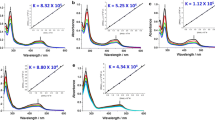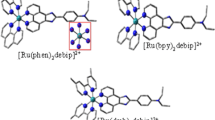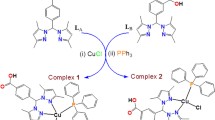Abstract
The synthesis and characterization of two half-sandwich complexes of Ru(II) and Ir(III) with thiabendazole as ancillary ligand and their DNA binding ability were investigated using experimental and computational methods. 1H NMR and acid–base studies have shown that aquo-complexes are the reactive species. Kinetic studies show that both complexes bind covalently to DNA through the metal site and non covalently through the ancillary ligand. Thermal stability studies, viscosity, circular dichroism measurements and quantum chemical calculations have shown that the covalent binding causes breaking of the H-bonding between base pairs, bringing about DNA denaturation and compaction. Additionally, molecular dynamics (MD) simulations and quantum mechanics/molecular mechanics (QM/MM) calculations shed light into the binding features of the Ru(II) and Ir(III) complexes and their respective enantiomers toward double-helical DNA, highlighting the important role played by the NˆN ancillary ligand once the complexes are covalently linked to DNA. Moreover, metal quantification in the nucleus of SW480 colon adenocarcinoma cells were carried out by inductively coupled plasma–mass spectrometry (ICP–MS), both complexes are more internalized than cisplatin after 4 h of exposition. However, in spite of the dramatic changes in the helicity of the DNA secondary structure induced by these complexes and their nuclear localization, antiproliferative studies have revealed that both, Ru(II) and Ir(III) complexes, cannot be considered cytotoxic. This unexpected behavior can be justified by the fast formation of aquo-complexes, which may react with components of the cell culture medium or the cytoplasm compartment in such a way that they may become deactivated before reaching DNA.
Graphic abstract















Similar content being viewed by others
References
Bray F, Ferlay J, Soerjomataram I et al (2018) Global cancer statistics 2018: GLOBOCAN estimates of incidence and mortality worldwide for 36 cancers in 185 countries. CA Cancer J Clin 68:394–424. https://doi.org/10.3322/caac.21492
Galluzzi L, Senovilla L, Vitale I et al (2012) Molecular mechanisms of cisplatin resistance. Oncogene 31:1869–1883. https://doi.org/10.1038/onc.2011.384
Florea A-M, Büsselberg D (2011) Cisplatin as an anti-tumor drug: cellular mechanisms of activity, drug resistance and induced side effects. Cancers (Basel) 3:1351–1371. https://doi.org/10.3390/cancers3011351
Zeng L, Gupta P, Chen Y et al (2017) The development of anticancer ruthenium(II) complexes: from single molecule compounds to nanomaterials. Chem Soc Rev 46:5771–5804. https://doi.org/10.1039/C7CS00195A
Nhukeaw T, Hongthong K, Dyson PJ, Ratanaphan A (2019) Cellular responses of BRCA1-defective HCC1937 breast cancer cells induced by the antimetastasis ruthenium(II) arene compound RAPTA-T. Apoptosis 24:612–622. https://doi.org/10.1007/s10495-019-01544-w
Rausch M, Dyson PJ, Nowak-Sliwinska P (2019) Recent considerations in the application of RAPTA-C for cancer treatment and perspectives for its combination with immunotherapies. Adv Ther 2:1900042. https://doi.org/10.1002/adtp.201900042
Murray BS, Babak MV, Hartinger CG, Dyson PJ (2016) The development of RAPTA compounds for the treatment of tumors. Coord Chem Rev 306:86–114. https://doi.org/10.1016/j.ccr.2015.06.014
Zhang J, Zhao C, Gao Y et al (2013) Thiabendazole, a well-known antifungal drug, exhibits anti-metastatic melanoma B16F10 activity via inhibiting VEGF expression and inducing apoptosis. Pharmazie 68:962–968
Fujii T, Mikuriya H, Sasaki M (1991) Chronic oral toxicity and carcinogenicity study of thiabendazole in rats. Food Chem Toxicol 29:771–775. https://doi.org/10.1016/0278-6915(91)90186-B
Mizutani T, Yoshida K, Ito K, Kawazoe S (1992) Sex difference in the nephrotoxicity of thiabendazole in mice depleted of glutathione by treatment with DL-buthionine sulphoximine. Food Chem Toxicol 30:247–250. https://doi.org/10.1016/0278-6915(92)90040-R
Süss-Fink G (2010) Arene ruthenium complexes as anticancer agents. Dalt Trans 39:1673–1688. https://doi.org/10.1039/B916860P
Liu H-K, Berners-Price SJ, Wang F et al (2006) Diversity in Guanine-Selective DNA binding modes for an organometallic ruthenium arene complex. Angew Chemie Int Ed 45:8153–8156. https://doi.org/10.1002/anie.200602873
Chen H, Parkinson JA, Parsons S et al (2002) Organometallic ruthenium(II) diamine anticancer complexes: arene-nucleobase stacking and stereospecific hydrogen-bonding in guanine adducts. J Am Chem Soc 124:3064–3082. https://doi.org/10.1021/ja017482e
Medici S, Peana M, Nurchi VM et al (2015) Noble metals in medicine: latest advances. Coord Chem Rev 284:329–350. https://doi.org/10.1016/j.ccr.2014.08.002
Liu Z, Habtemariam A, Pizarro AM et al (2011) Organometallic half-sandwich iridium anticancer complexes. J Med Chem 54:3011–3026. https://doi.org/10.1021/jm2000932
Pérez-Arnaiz C, Acuña MI, Busto N et al (2018) Thiabendazole-based Rh(III) and Ir(III) biscyclometallated complexes with mitochondria-targeted anticancer activity and metal-sensitive photodynamic activity. Eur J Med Chem 157:279–293. https://doi.org/10.1016/j.ejmech.2018.07.065
Huang Y-C, Haribabu J, Chien C-M et al (2019) Half-sandwich Ru(η6-p-cymene) complexes featuring pyrazole appended ligands: synthesis, DNA binding and in vitro cytotoxicity. J Inorg Biochem 194:74–84. https://doi.org/10.1016/j.jinorgbio.2019.02.012
Vekariya PA, Karia PS, Bhatt BS, Patel MN (2018) Effect of substituents on the biological activities of piano stool η5-cyclopentadienyl Rh(III) and Ir(III) complexes. J Inorg Organomet Polym Mater 28:2749–2758. https://doi.org/10.1007/s10904-018-0957-x
Liu Z, Romero-Canelón I, Habtemariam A et al (2014) Potent Half-Sandwich Iridium(III) anticancer complexes containing C∧N-chelated and pyridine ligands. Organometallics 33:5324–5333. https://doi.org/10.1021/om500644f
Li J, Tian Z, Xu Z et al (2018) Highly potent half-sandwich iridium and ruthenium complexes as lysosome-targeted imaging and anticancer agents. Dalt Trans 47:15772–15782. https://doi.org/10.1039/C8DT02963F
Djukić M, Jeremić MS, Jelić R et al (2018) Further insights into ruthenium(II) piano-stool complexes with N-alkyl imidazoles. Inorganica Chim Acta 483:359–370. https://doi.org/10.1016/j.ica.2018.08.031
Brissos RF, Clavero P, Gallen A et al (2018) Highly Cytotoxic Ruthenium(II)-arene complexes from bulky 1-pyrenylphosphane ligands. Inorg Chem 57:14786–14797. https://doi.org/10.1021/acs.inorgchem.8b02541
Yaman PK, Şen B, Karagöz CS, Subaşı E (2017) Half-sandwich ruthenium-arene complexes with thiophen containing thiosemicarbazones: synthesis and structural characterization. J Organomet Chem 832:27–35. https://doi.org/10.1016/j.jorganchem.2017.01.013
Yang Y, Guo L, Ge X et al (2019) Structure-activity relationships for highly potent half-sandwich organoiridium(III) anticancer complexes with C^N-chelated ligands. J Inorg Biochem 191:1–7. https://doi.org/10.1016/j.jinorgbio.2018.11.007
Erkkila EK, Odom TD, Barton KJ (1999) Recognition and reaction of metallointercalators with DNA. Chem Rev 99:2777–2796. https://doi.org/10.1021/cr9804341
Bencini A, Lippolis V (2010) 1,10-Phenanthroline: a versatile building block for the construction of ligands for various purposes. Coord Chem Rev 254:2096–2180. https://doi.org/10.1016/j.ccr.2010.04.008
Liu HK, Parkinson JA, Bella J et al (2010) Penetrative DNA intercalation and G-base selectivity of an organometallic tetrahydroanthracene RuII anticancer complex. Chem Sci 1:258–270. https://doi.org/10.1039/c0sc00175a
Aird RE, Cummings J, Ritchie AA et al (2002) In vitro and in vivo activity and cross resistance profiles of novel ruthenium (II) organometallic arene complexes in human ovarian cancer. Br J Cancer 86:1652–1657. https://doi.org/10.1038/sj.bjc.6600290
Yellol GS, Donaire A, Yellol JG et al (2013) On the antitumor properties of novel cyclometalated benzimidazole Ru(ii), Ir(iii) and Rh(iii) complexes. Chem Commun 49:11533. https://doi.org/10.1039/c3cc46239k
Yan YK, Melchart M, Habtemariam A, Sadler PJ (2005) Organometallic chemistry, biology and medicine: ruthenium arene anticancer complexes. Chem Commun. https://doi.org/10.1039/b508531b
Blunden BM, Stenzel MH (2015) Incorporating ruthenium into advanced drug delivery carriers—an innovative generation of chemotherapeutics. J Chem Technol Biotechnol 90:1177–1195. https://doi.org/10.1002/jctb.4507
Busto N, Valladolid J, Aliende C et al (2012) Preparation of organometallic ruthenium-arene-diaminotriazine complexes as binding agents to DNA. Chem An Asian J 7:788–801. https://doi.org/10.1002/asia.201100883
Busto N, Valladolid J, Martínez-Alonso M et al (2013) Anticancer activity and DNA binding of a bifunctional Ru(II) arene aqua-complex with the 2,4-diamino-6-(2-pyridyl)-1,3,5-triazine Ligand. Inorg Chem 52:9962–9974. https://doi.org/10.1021/ic401197a
Martínez-Alonso M, Busto N, Jalón FA et al (2014) Derivation of structure-activity relationships from the anticancer properties of ruthenium(II) arene complexes with 2-aryldiazole ligands. Inorg Chem 53:11274–11288. https://doi.org/10.1021/ic501865h
Busto N, Martínez-Alonso M, Leal JM et al (2015) Monomer-dimer divergent behavior toward DNA in a half-sandwich ruthenium(II) aqua complex. Antiproliferative biphasic activity. Organometallics 34:319–327. https://doi.org/10.1021/om5011275
Lozano HJ, Busto N, Espino G et al (2017) Interstrand DNA covalent binding of two dinuclear Ru(< scp > ii </scp >) complexes. Influence of the extra ring of the bridging ligand on the DNA interaction and cytotoxic activity. Dalt Trans 46:3611–3622. https://doi.org/10.1039/C6DT04888A
Pérez-Arnaiz C, Busto N, Santolaya J et al (2018) Kinetic evidence for interaction of TMPyP4 with two different G-quadruplex conformations of human telomeric DNA. Biochim Biophys Acta Gen Subj 1862:522–531. https://doi.org/10.1016/j.bbagen.2017.10.020
Zelonka RA, Baird MC (1972) Benzene complexes of ruthenium(II). Can J Chem 50:3063–3072. https://doi.org/10.1139/v72-486
Koelle U, Kossakowski J, Grumbine D, Tilley TD (2007) Di-μ-Chloro-Bis[(η5 -Pentamethylcyclopentadienyl) Chlororuthenium(III)], [Cp * RuCl 2] 2 and Di-μ-methoxo-Bis(η 5 -Pentamethylcyclopentadienyl)diruthenium(II). [Cp * RuOMe] 2007:2225–228
Fulmer GR, Miller AJM, Sherden NH et al (2010) NMR chemical shifts of trace impurities: common laboratory solvents, organics, and gases in deuterated solvents relevant to the organometallic chemist. Organometallics 29:2176–2179. https://doi.org/10.1021/om100106e
Po HN, Senozan NM (2001) The Henderson-Hasselbalch equation: its history and limitations. J Chem Educ 78:1499. https://doi.org/10.1021/ed078p1499
Stewart JJP (2007) Optimization of parameters for semiempirical methods V: modification of NDDO approximations and application to 70 elements. J Mol Model 13:1173–1213. https://doi.org/10.1007/s00894-007-0233-4
Zhao Y, Truhlar DG (2008) The M06 suite of density functionals for main group thermochemistry, thermochemical kinetics, noncovalent interactions, excited states, and transition elements: two new functionals and systematic testing of four M06-class functionals and 12 other function. Theor Chem Acc 120:215–241. https://doi.org/10.1007/s00214-007-0310-x
Adamo C, Barone V (1999) Toward reliable density functional methods without adjustable parameters: the PBE0 model. J Chem Phys 110:6158–6170. https://doi.org/10.1063/1.478522
Becke AD (1993) Density-functional thermochemistry. 3. The role of exact exchange. J Chem Phys 98:5648–5652. https://doi.org/10.1063/1.464913
Lee C, Yang W, Parr RG (1988) Development of the Colle-Salvetti correlation-energy formula into a functional of the electron density. Phys Rev B 37:785–789. https://doi.org/10.1103/PhysRevB.37.785
Stevens WJ, Basch H, Krauss M (1984) Compact effective potentials and efficient shared-exponent basis sets for the first- and second-row atoms. J Chem Phys 81:6026–6033. https://doi.org/10.1063/1.447604
Busto N, Calvo P, Santolaya J et al (2018) Fishing for G-quadruplexes in solution with a perylene diimide derivative labeled with biotins. Chem A Eur J 24:11292–11296. https://doi.org/10.1002/chem.201802365
Rackers JA, Wang Z, Lu C et al (2018) Tinker 8: software tools for molecular design. J Chem Theory Comput 14:5273–5289. https://doi.org/10.1021/acs.jctc.8b00529
Maestro (2015) Version 10.2. Schrödinger, LLC, New York, NY. https://www.schrodinger.com/maestro
Adeniyi AA, Ajibade PA (2016) Exploring the ruthenium-ligands bond and their relative properties at different computational methods. J Chem 2016:1–15. https://doi.org/10.1155/2016/3672062
Banci L, Gori-Savellini G, Turano P (1997) A molecular dynamics study in explicit water of the reduced and oxidized forms of yeast iso-1-cytochrome c. solvation and dynamic properties of the two oxidation states. Eur J Biochem 249:716–723. https://doi.org/10.1111/j.1432-1033.1997.t01-1-00716.x
Chung LW, Sameera WMC, Ramozzi R et al (2015) The ONIOM method and its applications. Chem Rev 115:5678–5796. https://doi.org/10.1021/cr5004419
Vreven T, Morokuma K (2006) Hybrid methods: ONIOM(QM:MM) and QM/MM, Chap 4. In: Spellmeyer DC (ed) Annual reports in computational chemistry, vol 2. Elsevier, pp 35–51
Dapprich S, Komáromi I, Byun KS et al (1999) A new ONIOM implementation in Gaussian98. Part I. The calculation of energies, gradients, vibrational frequencies and electric field derivatives. J Mol Struct Theochem 461–462:1–21. https://doi.org/10.1016/S0166-1280(98)00475-8
Hay PJ, Wadt WR (1985) Ab initio effective core potentials for molecular calculations. Potentials for the transition metal atoms Sc to Hg. J Chem Phys 82:270–283. https://doi.org/10.1063/1.448799
Frisch MJ, Trucks GW, Schlegel HB, Scuseria GE, Robb MA, Cheeseman JR, Scalmani G, Barone V, Mennucci B, Petersson GA, Nakatsuji H, Caricato M, Li X, Hratchian HP, Izmaylov AF, Bloino J, Zheng G, Sonnenberg JL, Hada M, Ehara M, Toyota K, Fukuda R, Hasegawa J, Ishida M, Nakajima T, Honda Y, Kitao O, Nakai H, Vreven T, Montgomery JA Jr., Peralta JE, Ogliaro F, Bearpark M, Heyd JJ, Brothers E, Kudin KN, Staroverov VN, Kobayashi R, Normand J, Raghavachari K, Rendell A, Burant JC, Iyengar SS, Tomasi J, Cossi M, Rega N, Millam JM, Klene M, Knox JE, Cross JB, Bakken V, Adamo C, Jaramillo J, Gomperts R, Stratmann RE, Yazyev O, Austin AJ, Cammi R, Pomelli C, Ochterski JW, Martin RL, Morokuma K, Zakrzewski VG, Voth GA, Salvador P, Dannenberg JJ, Dapprich S, Daniels AD, Farkas Ö, Foresman JB, Ortiz JV, Cioslowski J, Fox DJ (2009) Gaussian 09, Revision A.02. Gaussian, Inc., Wallingford, CT
Bonsignore R, Terenzi A, Spinello A et al (2016) G-quadruplex vs. duplex-DNA binding of nickel(II) and zinc(II) Schiff base complexes. J Inorg Biochem 161:115–121. https://doi.org/10.1016/j.jinorgbio.2016.05.010
Bonsignore R, Russo F, Terenzi A et al (2018) The interaction of Schiff Base complexes of nickel(II) and zinc(II) with duplex and G-quadruplex DNA. J Inorg Biochem 178:106–114. https://doi.org/10.1016/j.jinorgbio.2017.10.010
Pérez-Arnaiz C, Leal J, Busto N et al (2018) Role of seroalbumin in the cytotoxicity of cis-dichloro Pt(II) complexes with (N^N)-donor ligands bearing functionalized tails. Inorg Chem 57:6124–6134. https://doi.org/10.1021/acs.inorgchem.8b00713
Brandhorst K, Grunenberg J (2008) How strong is it? The interpretation of force and compliance constants as bond strength descriptors. Chem Soc Rev 37:1558. https://doi.org/10.1039/b717781j
Brandhorst K, Grunenberg J (2010) Efficient computation of compliance matrices in redundant internal coordinates from Cartesian Hessians for nonstationary points. J Chem Phys 132:184101. https://doi.org/10.1063/1.3413528
Li ZF, Lam YW (2015) A new rapid method for isolating nucleoli. In: The nucleus. Methods in molecular biology (methods and protocols), vol 1228. Humana Press, New York, pp 35–42
Jennerwein M, Andrews PA (1995) Effect of intracellular chloride on the cellular pharmacodynamics of cis-diamminedichloroplatinum(II). Drug Metab Dispos 23:178–184
Cavalcanti GRS, Fonseca MG, da Silva Filho EC, Jaber M (2019) Thiabendazole/bentonites hybrids as controlled release systems. Colloids Surf B Biointerfaces 176:249–255. https://doi.org/10.1016/j.colsurfb.2018.12.030
Haga MA (1983) Synthesis and protonation-deprotonation reactions of ruthenium(II) complexes containing 2, 2′-bibenzimidazole and related ligands. Inorg Chim Acta 75:29–35. https://doi.org/10.1016/S0020-1693(00)91186-1
Dömötör O, Pape VFS, May NV et al (2017) Comparative solution equilibrium studies of antitumor ruthenium(η6-p-cymene) and rhodium(η5-C5Me5) complexes of 8-hydroxyquinolines. Dalt Trans 46:4382–4396. https://doi.org/10.1039/c7dt00439g
Wang F, Habtemariam A, van der Geer EPL et al (2005) Controlling ligand substitution reactions of organometallic complexes: tuning cancer cell cytotoxicity. Proc Natl Acad Sci 102:18269–18274. https://doi.org/10.1073/pnas.0505798102
Brabec V, Nováková O (2006) DNA binding mode of ruthenium complexes and relationship to tumor cell toxicity. Drug Resist Updat 9:111–122. https://doi.org/10.1016/j.drup.2006.05.002
Valladolid J, Hortigüela C, Busto N et al (2014) Phenanthroline ligands are biologically more active than their corresponding ruthenium(ii) arene complexes. Dalt Trans 43:2629–2645. https://doi.org/10.1039/c3dt52743c
Pérez-Arnaiz C, Busto N, Leal JM, García B (2014) New Insights Into The Mechanism of the DNA/doxorubicin interaction. J Phys Chem B 118:1288–1295. https://doi.org/10.1021/jp411429g
Drummond DS, Pritchard NJ, Simpson-Gildemeister VFW, Peacocke AR (1966) Interaction of aminoacridines with deoxyribonucleic acid: viscosity of the complexes. Biopolymers 4:971–987. https://doi.org/10.1002/bip.1966.360040903
Buceta D, Busto N, Barone G et al (2015) Ag 2 and Ag 3 clusters: synthesis, characterization, and interaction with DNA. Angew Chemie Int Ed 54:7612–7616. https://doi.org/10.1002/anie.201502917
Gil-García R, Ugalde M, Busto N et al (2016) Selectivity of a thiosemicarbazonatocopper(II) complex towards duplex RNA. Relevant noncovalent interactions both in solid state and solution. Dalt Trans 45:18704–18718. https://doi.org/10.1039/C6DT02907H
Cerón-Carrasco JP, Ruiz J, Vicente C et al (2017) DFT Simulation of structural and optical properties of 9-aminoacridine half-sandwich Ru(II), Rh(III), and Ir(III) antitumoral complexes and their interaction with DNA. J Chem Theory Comput 13:3898–3910. https://doi.org/10.1021/acs.jctc.7b00139
Habtemariam A, Melchart M, Fernández R et al (2006) Structure − Activity relationships for cytotoxic ruthenium(II) arene complexes containing N, N-, N, O-, and O, O-Chelating ligands. J Med Chem 49:6858–6868. https://doi.org/10.1021/jm060596m
Grgurić-Šipka S, Ivanović I, Rakić G et al (2010) Ruthenium(II)–arene complexes with functionalized pyridines: synthesis, characterization and cytotoxic activity. Eur J Med Chem 45:1051–1058. https://doi.org/10.1016/j.ejmech.2009.11.055
Acknowledgements
The authors gratefully acknowledge the financial support by “la Caixa” Banking Foundation (LCF/PR/PR12/11070003), Consejería de Educación-Junta de Castilla y León-FEDER (BU042U16-BU305P18), Ministerio de Ciencia, Innovación y Universidades (RTI2018-102040-B-100) and networking support by the COST Action CA18202.
Author information
Authors and Affiliations
Corresponding author
Ethics declarations
Conflict of interest
The authors declare that they have no conflict of interest.
Additional information
Publisher's Note
Springer Nature remains neutral with regard to jurisdictional claims in published maps and institutional affiliations.
Electronic supplementary material
Below is the link to the electronic supplementary material.
Rights and permissions
About this article
Cite this article
Santolaya, J., Busto, N., Martínez-Alonso, M. et al. Experimental and theoretical characterization of the strong effects on DNA stability caused by half-sandwich Ru(II) and Ir(III) bearing thiabendazole complexes. J Biol Inorg Chem 25, 1067–1083 (2020). https://doi.org/10.1007/s00775-020-01823-x
Received:
Accepted:
Published:
Issue Date:
DOI: https://doi.org/10.1007/s00775-020-01823-x




